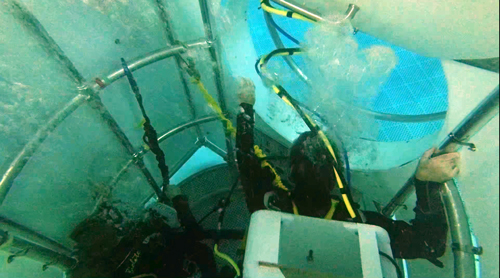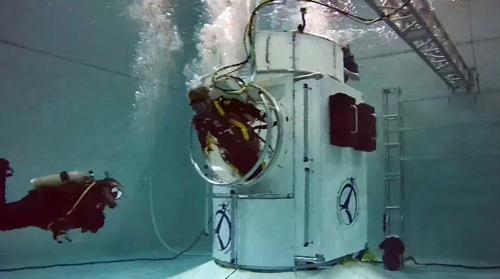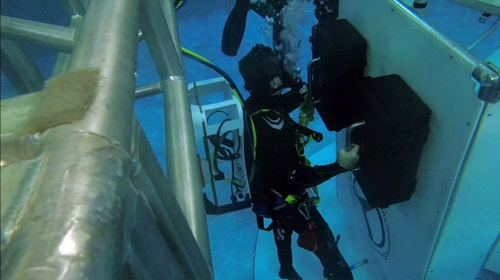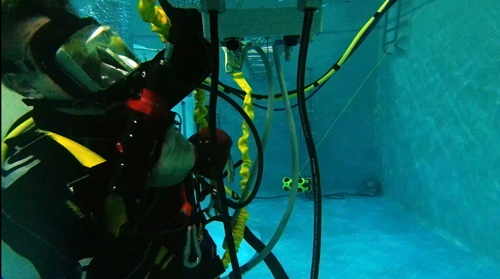Posey's Moonshot
Some Fumbles and a Lot of Wonder During My First Underwater EVA
Even before I ever started training to go to space, one of the training activities that I was most excited about was an underwater EVA. EVA stands for extravehicular activity. In this context, it's basically a spacewalk. Astronauts do the bulk of their EVA training in swimming pools while wearing suits that are weighted in a way that makes them neutrally buoyant. Neutral buoyancy, while not a perfect analog, is used to mimic zero gravity.
Several months ago, I explained that I was finally going to get the chance to do my first underwater EVA, and what that EVA would tentatively consist of. Although my underwater EVA was delayed, I finally got to do it last week. The experience was far different from what I had imagined, and yet it was every bit as satisfying as I had anticipated.
One of the things that made my underwater EVA so different from my expectations was that I was not wearing a spacesuit. I know that sounds strange, but there was a good reason for it. Because of COVID, I had not worn an EVA spacesuit in two years. It would have been extraordinarily dangerous to use the suit underwater without first undergoing extensive training to refamiliarize myself with the suit. Incidentally, I have spent quite a bit of time in an IVA (intravehicular activity) spacesuit in recent weeks.
Prior to my underwater EVAs, I had to get dry suit-certified. I have been scuba-certified for about 30 years, but have always dove in warm water and thus had zero dry suit experience. One of the things that really surprised me about the dry suit is that it actually works very similarly to a spacesuit.
Spacesuits do more than just give you air to breathe. A spacesuit is inflatable. When you inflate the suit, it creates pressure all around your body. This air pressure is essential to staying alive in space. The pressure in the suit is what protects your body from the vacuum of space.
Like a spacesuit, a dry suit also has a valve that can be used to inflate the suit. Whereas the pressure in a spacesuit protects you against the vacuum of space, however, the air that is added to a dry suit helps with buoyancy control.
Another way that the instructors tried to somewhat mimic spacesuit operations was by requiring the use of a full face mask (which required yet another new scuba certification). The idea behind using a full face mask was that it would allow for the use of comms. Normally, when you are scuba diving, you have a regulator in your mouth, which makes it impossible to talk. A full face mask provides air without you having to put a regulator in your mouth, thus making it possible to incorporate communications devices into the mask.
In retrospect, the dry suit and full face mask were not ideal substitutes for a spacesuit, but they were certainly good enough for the situation. The instructors added other elements such as a backpack, harness and umbilical that would make the experience more like wearing a spacesuit and less like scuba diving (they also made us dive without fins so that we could not swim through the water). Weighting the suit to mimic zero gravity helped complete the illusion.
The EVAs began inside an underwater mockup of the International Space Station's Quest airlock. Another astronaut candidate who worked through the EVAs and I started the simulation by tethering ourselves to the inside of the airlock and then opening the hatch.
 Figure 1: The airlock (which is open in this picture) has just enough room for two suited astronauts.
Figure 1: The airlock (which is open in this picture) has just enough room for two suited astronauts.
Even though it is hard to put into words, making my way out of the airlock was one of those really incredible moments that I sometimes experience during my spaceflight training. Even though the Quest airlock is large enough to hold two suited astronauts, the mockup we were using still feels somewhat dark and confining. When I opened the hatch and left the airlock, I was suddenly in a vastly larger area and had the entire expanse of the swimming pool suddenly before me. I know it sounds strange, but I honestly felt as though I were stepping out into space. The illusion was further enhanced by the presence of the ISS mockup. The pool wasn't big enough to recreate the entire space station, but the components that we did have certainly gave me a good taste of what it might be like to do an EVA on the ISS.
 Figure 2: A safety diver looks on as I leave the airlock.
Figure 2: A safety diver looks on as I leave the airlock.
My suit was equipped with two tethers, and one tether always had to be attached to the ISS mockup (to prevent me from floating away). Making my way along the outside of the space station meant continuously moving the tethers in my direction of travel.
My task for the EVAs was to replace a failed component that was mounted on a truss. This meant that when I left the airlock, I had to make my way toward a pair of toolboxes and retrieve the tools that would be required for the job. I had to clip the tools to my suit in order to prevent them from floating away. I then made my way along a truss until I located the component that needed to be replaced.
 Figure 3: I had to retrieve tools and replacement parts from toolboxes located on the outside of the airlock.
Figure 3: I had to retrieve tools and replacement parts from toolboxes located on the outside of the airlock.
The replacement process required me to disconnect a series of data cables and fluid hoses and then use a drill to remove several screws. One of the things that made this particularly challenging was that the component that I was replacing was mounted upside down, underneath the truss. Additionally, I had to be really careful to avoid dropping screws or losing tools since in space they would have simply floated away. Incidentally, I did lose one screw.
 Figure 4: I had to use an underwater drill to remove screws during my EVA. The robotic submarine (ROV) in the background transmitted live video to the mission controllers who were monitoring my EVA from the surface.
Figure 4: I had to use an underwater drill to remove screws during my EVA. The robotic submarine (ROV) in the background transmitted live video to the mission controllers who were monitoring my EVA from the surface.
 Figure 5: Safety divers monitor myself and my partner as we work to complete the repair.
Figure 5: Safety divers monitor myself and my partner as we work to complete the repair.
Once the replacement was done, I had to reconnect all of the cables and hoses, make my way back to the toolbox, and stow the tools that I had used. It was then time to reenter and then seal the airlock, at which point the simulation ended.
In case you are wondering, I ran through the simulation multiple times. My first simulation was disastrous because I was having a lot of issues with my dive gear. My EVA partner did nearly all of the work on that simulation.
My last simulation, however, went really well. I almost felt as though numerous life experiences all came together to help me to complete the EVA. I'm talking about things like scuba experience, home improvement projects (and using power tools), my IT career (and working with data cables), and much more. Performing an underwater EVA was truly the incredible experience that I always thought that it would be and I am looking forward to the next one, which will hopefully be in a spacesuit.
About the Author
Brien Posey is a 22-time Microsoft MVP with decades of IT experience. As a freelance writer, Posey has written thousands of articles and contributed to several dozen books on a wide variety of IT topics. Prior to going freelance, Posey was a CIO for a national chain of hospitals and health care facilities. He has also served as a network administrator for some of the country's largest insurance companies and for the Department of Defense at Fort Knox. In addition to his continued work in IT, Posey has spent the last several years actively training as a commercial scientist-astronaut candidate in preparation to fly on a mission to study polar mesospheric clouds from space. You can follow his spaceflight training on his Web site.